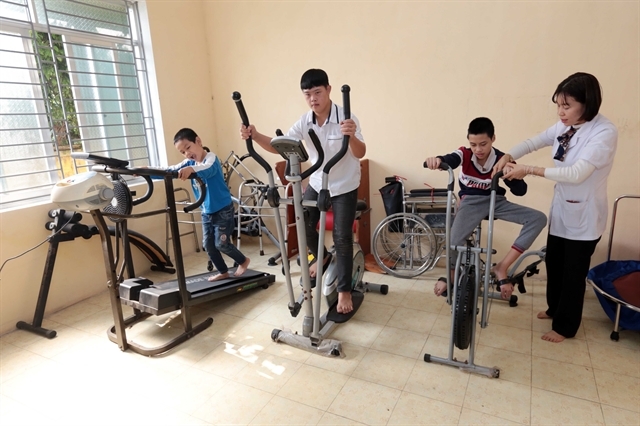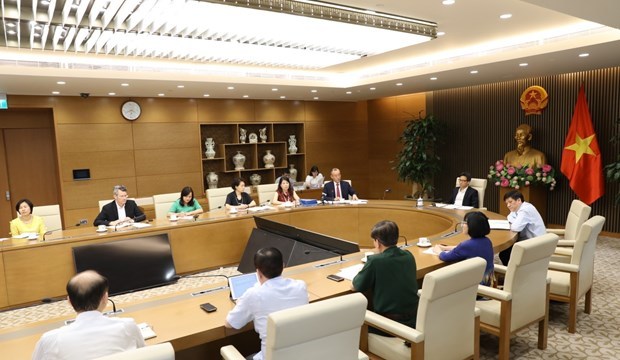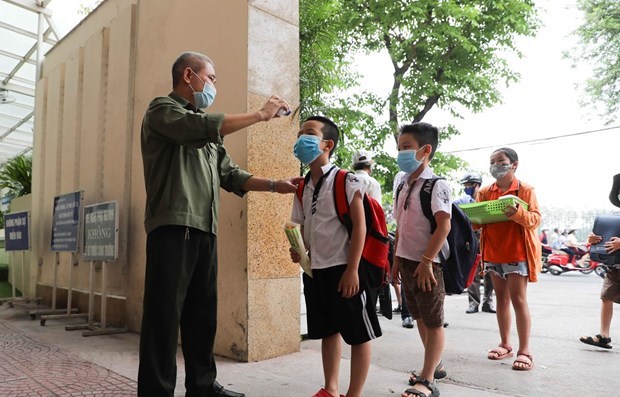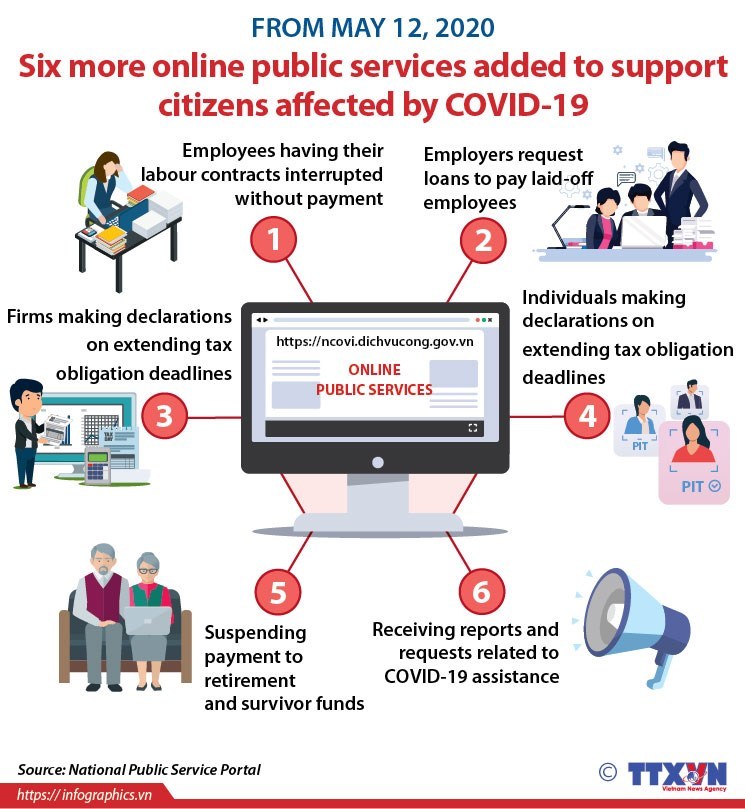 |
|
People with disabilities exercise at a rehabilitation school in Khoái Châu District, northern province of Hưng Yên.
|
People with disabilities were among the hardest hit by the COVID-19 pandemic, said a rapid assessment announced by the United Nations Development Programme (UNDP) on Tuesday.
With support from the Australian Department of Foreign Affairs and Trade, the Embassy of Ireland in Việt Nam and the Korea International Cooperation Agency, the UNDP organised the assessment to help identify health and socio-economic challenges faced by people with disabilities and their families during COVID-19 to offer targeted support and responses for them.
Nearly 1,000 people with different disabilities - physical, hearing and speech, visual and psychosocial, including those from ethnic minority groups from cities and provinces throughout the country - participated in the assessment.
The rapid assessment reveals that 82 per cent of respondents expressed concern about protecting their health and 96 per cent expressed concern for their financial security during COVID-19.
Up to 70 per cent of respondents had found it challenging to access medical care, including check-ups, medicine, assistive devices and rehabilitation services, whereas 22 per cent of them were suffering from underlying medical conditions potentially putting them at heightened risk of COVID-19.
As of March 2020, 72 per cent of people with disabilities across the country had a monthly income of less than VNĐ1 million (US$43).
As many as 30 per cent of them had been made unemployed due to COVID-19, whereas 49 per cent were working reduced hours and 59 per cent had taken a pay cut.
More than 70 per cent of working people with disabilities had seasonal jobs or owned an informal business, so were at risk of being ineligible for allowances from the Government’s social welfare response package, said the assessment.
Addressing the launch, UNDP Resident Representative in Việt Nam Caitlin Wiesen highlighted the importance of a disability-inclusive response to the efforts underway to address COVID-19.
“While people living with disabilities have been disproportionately impacted by COVID-19, at the same time, they have a vital role and contribution to make in overcoming and co-existing safely with COVID-19 in Việt Nam,” she said.
“We must support persons with disabilities to develop skillsets to make full use of new digital platforms, creating more working from home and online employment opportunities, that enable them to work safely and competitively in the new industry 4.0 environment,” she said.
New ways of working could help many persons with disabilities to improve their income opportunities and continue to make significant contributions to Việt Nam’s economic recovery, she added.
The report suggested providing emergency relief for the urgent needs of persons with disabilities, including medical care and services, and telehealth services where appropriate.
The aim of the report was to ensure that the Government’s support package was disability-inclusive in the informal sector and ensured people with disabilities’ financial security and education continuation with the provision of online jobs, accessible applications and digital platforms.
The rapid assessment suggested extending coverage of disability certificates to include the wider population of people with disabilities and conducting a comprehensive assessment of the impacts of COVID-19 on people with disabilities, with the full participation of those in the country, to design and implement response and recovery programmes.
Vietnam stays on guard in response to COVID-19 developments: Deputy PM
 |
| The meeting of the national steering committee for COVID-19 prevention and control, WHO, international organisations and some sectors in Hanoi on May 12 |
Facing complex developments of COVID-19 around the world, anti-pandemic forces of Vietnam always stand ready to respond, Deputy Prime Minister Vu Duc Dam said at a meeting with representatives of the World Health Organisation (WHO), international organisations and some sectors in Hanoi on May 12.
Deputy Minister of Health Nguyen Thanh Long reported that Vietnam hasn’t recorded new infections of SARS-CoV-2, the virus that causes COVID-19, in the community for 26 consecutive days, and it is still carrying out surveillance of risk populations.
About 1,200 – 2,000 samples are tested each day, and tests of 275,000 samples collected so far have discovered 288 infected cases, most of which were in quarantine facilities, he noted, adding that epidemiological factors and risks of community transmission in Vietnam are very low at present.
Therefore, the country is pressing on with thoroughly preventing transmission from other countries, strictly quarantining those entering Vietnam for 14 days and taking samples from them for testing twice a day, maintaining the monitoring and testing system to early detect infections in the community, sealing off areas with infected cases, improving the medical staff’s capacity, and boosting the production of medical equipment, medicine and other supplies, Long said.
Recognising local efforts in the COVID-19 fight, WHO Representative in Vietnam Kidong Park said the country has taken early actions and had drastic measures in response to each infection.
However, he also warned that as there is no medicine specialised in COVID-19 treatment or a vaccine, and the pandemic is forecast to linger, Vietnam needs to stay vigilant and keep a close watch on the situation. Besides, although Vietnam doesn’t have infected cases in the community, other countries in the region and the world are still struggling with the pandemic.
Risks of community infection still exist, he said, recommending it gear up for new cases and even a “new wave” of infections so as to actively control the pandemic like when the “first wave” occurred.
In the time ahead, WHO will continue working closely with the Government, the national steering committee for COVID-19 prevention and control, and the Health Ministry of Vietnam to exchange information, update technical guidelines, and share Vietnam’s experience with the international community, Park said.
Appreciating WHO and foreign experts’ cooperation and assistance, Deputy PM Dam, who is also head of the national steering committee, expressed his hope for further coordination, noting that Vietnam is ready to share information, initiatives, and experience in the COVID-19 prevention and control with the international community, especially low-income and developing nations.
He stressed that anti-pandemic forces like health workers, military and police always stay ready, and that Vietnam is keeping a tight control of people entering the country while easing restrictions within the country so as to realise the dual target of combating the pandemic and ensuring socio-economic development./.
US paper: Vietnam takes science-based approach to COVID-19
 |
|
|
The US’s Daily Hampshire Gazette has said Vietnam took a science-based approach to tackling COVID-19 pandemic.
In an article published on May 11, the author said the pandemic has caused more than 4.13 million infections and taken over 283,000 lives. Vietnam, which shares border with China, has recorded zero deaths so far. This is not because of low testing or poor record-keeping.
Rather than lockdown of the entire population, the anti-epidemic teams studied the population, and quarantined and treated those with symptoms and who tested positive for SARS-CoV-2. If there was a region with particularly high numbers, it was quarantined.
The article said the multi-tier quarantine system helped the Vietnamese authorities break the chain of infection. The Communist Party of Vietnam, very early, offered a motto “fighting the epidemic is like fighting against the enemy.”
Additionally, the Vietnamese Ministry of Health posed a music video to explain the concept of physical distancing and hand washing. This video went viral on TikTok, where young people created a dance to go with it. Masks were mandated in public and alcohol-based hand sanitizers are found everywhere. Schools and religious sites were all immediately closed.
The newspaper also pointed out that the Vietnamese Government directed the public sector to produce necessary equipment, including protective suits and ventilators, as well as hand sanitiser and medicines. The private sector followed suit, and so did philanthropists who set up “Rice ATMs” to distribute food to those who had lost their incomes. The government set up food kitchens to feed the poor.
The Vietnamese had already begun major preparations to contain the virus, including increasing capacity in medical institutions and for the production of necessary protective equipment, it said./.
 |
Embassy in Switzerland ensures citizen protection
 |
| Vietnamese people in the Czech Republic present face masks to Svec Tibor, Governor of Vestec township (second from left) |
The Vietnamese Embassy in Switzerland has taken drastic measures to assist the Vietnamese community and ensure citizen protection, as the outbreak of the disease has affected Vietnamese people in the country.
Vietnamese Ambassador Le Linh Lan said that there are 340 students and around 300 postgraduates learning in universities and colleges across Switzerland. Meanwhile, the overseas Vietnamese community living and working in the country number about 10,000 people.
The embassy quickly built response scenarios after the disease broke out, along with citizen protection measures, focusing on updating the Vietnamese community on the disease situation, the host country’s prevention recommendations and the Vietnamese Government’s related policies and plans, Lan stated.
She advised Vietnamese citizens, especially students, to stay calm and strictly follow Switzerland’s disease prevention measures and recommendations.
The Vietnamese community in Switzerland, in turn, has stayed united and join hands in the battles against the pandemic of both Vietnam and Switzerland.
Meanwhile, Marcel Winder, Honorary President of the Czech Republic-Vietnam Friendship Association, recently thanked the Vietnamese community in the Czech Republic for their contributions in the fight against the COVID-19 pandemic.
Since the first case was reported in the country on March 1, Vietnamese people have launched a campaign to sew face masks and raise funds to support local people, hospitals and authorised offices.
For example, the Vietnamese community in Cheb has donated 700,000 Koruna (27,680 USD) to the city’s hospital and fire fighting force, while the community in Ustínad Labem has presented 300,000 Koruna to Masaryk Hospital to buy ventilators./.
Hanoi provides medical supplies to help Moscow cope with COVID-19
|
|
| Chairman of the city People’s Committee Nguyễn Đức Chung (right, centre) presented medical supplies to Russian Ambassador to Việt Nam Konstantin Vnukov during a handover ceremony on Tuesday. |
On behalf of the Party organisation, administration and people of Hà Nội, Chairman of the city People’s Committee Nguyễn Đức Chung presented medical supplies to the Russian capital of Moscow and the Vietnamese community in the country on Tuesday, in support of efforts to fight the COVID-19 pandemic.
At the handover ceremony, Hà Nội presented 100,000 antibacterial cloth face masks and 50,000 medical face masks to Moscow, along with another 50,000 masks to the Vietnamese Embassy and Vietnamese community in Russia.
Chairman Chung said all countries are making every effort to contain the pandemic but none can single-handedly deal with the problem. Enhancing international cooperation and solidarity is therefore of critical importance to stopping the spread of the disease and minimising its socioeconomic impact on each nation and region.
Based on the Việt Nam-Russia comprehensive strategic partnership and the traditional friendship between the two capitals, the Party organisation, administration and people of Hà Nội wish to share some of their resources with Moscow’s administration and people in the fight against COVID-19, he noted.
For his part, Russian Ambassador to Việt Nam Konstantin Vnukov said that under the leadership of the Communist Party of Việt Nam and the country’s Government, necessary measures have been adopted to curb the pandemic and Việt Nam is now among the best performers in combating COVID-19.
On behalf of the Moscow administration and people, he thanked Hà Nội for the gifts.
Vietnam stays clear of COVID-19 community transmission for 27 days
|
|
|
Measuring students' body temperature |
No new COVID-19 infections were reported on May 13 morning, marking the 27th straight day Vietnam has gone without community transmission of the disease, according to the National Steering Committee for COVID-19 Prevention and Control.
The nation’s COVID-19 tally has remained at 288, including 148 imported ones. To date, 252 patients have been given the all-clear and no deaths have been reported.
Of the 36 patients still under treatment, seven have tested negative for SARS-CoV-2 once while nine others negative at least twice.
The 91st patient, treated at the Ho Chi Minh City Hospital for Tropical Diseases, is still in critical condition, while the 19th patient, who has been under treatment for over two months, has shown good recovery.
At present, a total of 12,634 people are kept in quarantine, including 322 at hospitals, 6,819 at other quarantine facilities, and the rest at home./.
Three more patients with COVID-19 recover, total at 252
 |
| A view of the the Củ Chi Field Hospital in HCM City. — Photo viettimes.vn |
Three more patients with COVID-19 recovered and were released from the Củ Chi Field Hospital in HCM City on Tuesday afternoon, bringing the country’s total recoveries to 252.
They are all Brazilian who tested positive again after previously being given the all-clear.
Patient 151, female, 45, tested positive again after being cleared on April 18. During treatment, the patient had many tests and all came back negative for SARS-CoV-2 from April 27 to May 10.
Patient 207, male, 49, also tested positive after being cleared on April 18. During treatment and monitoring in hospital, the patient’s tests were negative for SARS-CoV-2 continuously from April 27 to May 10.
Patient 224, male, 39, tested positive again after being declared clear of the disease on April 20. He had repeated SARS-CoV-2 negative test results from April 27 to May 10.
At present, all three patients have no fever, no cough, no breathing difficulties and are in a stable condition. They will continue to be isolated and monitored for the next 14 days, according to the Sub-Committee for Treatment of the National Steering Committee on COVID-19 Prevention and Control.
As of 6pm Tuesday afternoon, the Ministry of Health reported no new community transmission cases of COVID-19 over the past 26 days. The number of COVID-19 confirmed cases stands at 288 and no deaths have been reported.
|
|
|
|
 |
|
|
Photo exhibition to honour efforts against COVID-19
 |
| Journalist Vu Quoc Khanh, VAPA Chairman, speaks at the launch of the photo exhibition on May 11. |
The Vietnam Association of Photographic Artists (VAPA) is inviting photos of Vietnam in the combat against COVID-19 to an exhibition slated for June 1.
VAPA Chairman Vu Quoc Khanh said on May 11 that the event aims to push ahead with communications to raise public awareness of the pandemic, highlight Vietnam’s enormous achievements in the COVID-19 fight, and honour the photo takers.
The organising board said photos sent to the exhibition should depict the country and people in the disease prevention and control efforts, their daily lives in the pandemic, along with the exemplars and those working in the frontline.
Senders can be professional photographers, photo journalists or those able to take COVID-19-themed photos in Vietnam, and each can submit up to 20 works that are separate photos or groups of photos.
The exhibition is open for entries via website www.trienlamanhCovid-19.com from now through May 20. The best 150-200 items will be selected for the display.
The event will be held at the VAPA’s centre for artistic photo archives and exhibition in Hanoi.
More support for people affected by COVID-19
 |
| Local people affected by COVID-19 in An Hai Bac Ward, Son Tra District, Da Nang City, receive financial support from the State. |
More support has continued to be provided to disadvantaged people across the nation to help ease their difficulties due to the coronavirus disease (COVID-19).
Starting from today, May 12, the National Public Service Portal will provide six additional public services to support people and businesses that are facing difficulties amid the COVID-19 epidemic.
Accordingly, the services include supporting employees who postpone labour contracts or leave without pay, supporting employers to access loans to pay workers' discontinued wages, declaring the payment of enterprise income tax extension, declaration of personal tax payment extension, suspension of contribution to the pension and death benefit fund, and receiving and handling feedback and proposals from the public and enterprises at https://ncovi.dichvucong.gov.vn/p/home.
It is expected that the six new public services on the portal will support about 4 million workers and employers facing difficulties due to the epidemic, while also shortening the processing time from 6 to 10 working days for each object, compared to the direct implementation.
Meanwhile, disbursement of financial support for the disadvantaged under a VND62 trillion COVID-19 bailout package from the Government has been boosted to deliver timely assistance to those in need.
The Department of Labour, Invalids and Social Affairs of Phu Yen Province has said that eight out of the nine districts, towns and cities in the province have completed the review and got the nod from the provincial authorities on the list of groups who are eligible for receiving the financial support. They included people with meritorious services to the revolution, social protection beneficiaries and poor and near-poor households, with a total of 144,000 people. To date, some localities have disbursed VND146 billion for such groups. For other subjects, Phu Yen will rely on the guidance of the Ministry of Labour, Invalids and Social Affairs to survey, evaluate and make a specific list at a later date.
In Long An Province, the provincial Department of Labour, Invalids and Social Affairs and local authorities have reviewed and made a list of seven target groups to disburse the financial assistance. Up until now, VND144 billion has been distributed between 123,214 people in three groups of poor and near-poor households, people receiving monthly social allowances and people with meritorious services. The department is coordinating with localities to investigate, review and appraise the remaining four target groups to help them receive support as soon as possible.
On May 11, the Department of Labour, Invalids and Social Affairs of Da Nang City informed that the central coastal city has started to appraise profiles of workers and household businesses affected by COVID-19 for financial support disbursement. Accordingly, they belong to three groups: household businesses suspending operation, workers with labour contracts but are not entitled to unemployment benefits, and employees who do not have labour contracts but lost their jobs. After the list and support fund is approved, within nine days at the latest, payment will be made to employees. Da Nang has about 58,000 employees supported under the Government’s bailout package and the city is expected to spend more than VND200 billion to support these groups.
On the same day, in Thanh Hoa Province, the Thanh Hoa Association of Former Teachers presented VND120 million to the Thanh Hoa Fatherland Front Committee to support the fight against COVID-19 in the province. Entrepreneur Hoang Vy from Ho Chi Minh City also presented 1,500 gifts, with each containing 10 kg of rice and some basic necessities, to 400 patients who are receiving treatment at the Provincial General Hospital and Thanh Hoa Children's Hospital, in addition to 1,100 gifts for people in difficult circumstances in the two wards of Dong Ve and Quang Thanh in Thanh Hoa City.
Also, on May 11, Vinh Phuc Province Youth Union cooperated with Vinh Phuc Labour Union to offer free breakfast worth VND25,000 each (including milk and bread) to over 6,000 young workers suffering difficulties due to COVID-19 in local industrial zones and the workers’ boarding house area in Phuc Yen City. The programme will last until May 15.
In Hanoi, students of class 9A1 and the Board of Directors of Ngo Gia Tu Secondary School in Hai Ba Trung District have presented 160 gifts to disadvantaged classmates and some families facing difficulties due to COVID-19. The beneficiaries are mainly policy families, people with meritorious services and disadvantaged families in difficult circumstances living in the wards of Bach Mai and Bach Khoa. Each gift includes rice, cooking oil, books and school supplies purchased from money raised by the students and their parents.
Indonesia installs Covid-19 mobile labs at border checkpoints
 |
|
Indonesian crew workers from the Viking Orion cruise ship arrive at Tanjung Priok Port in Jakarta on May 11. (Photo: Antara)
|
Indonesia’s National Disaster Management Agency (BNPB) is setting up mobile laboratories at airports, seaports and border checkpoints around the country to test arrivals for COVID-19.
BNPB Secretary Harmensyah said on May 12 that Indonesian citizens stuck overseas, most of them migrant workers, are still being repatriated and the government is worried they might be bringing the coronavirus with them.
Polymerase chain reaction (PCR) testing is still the most reliable method to detect COVID-19 cases and labs to perform the test should be available at every entry point to Indonesia.
The BPPT (Technology Assessment and Application Agency) has developed a mobile BSL2 (biosafety level-2) laboratory capable of performing 262 PCR tests in 24 hours. The agency is working with teams from Gajah Mada University, Airlangga University and Hepatika Mataram to reach 10,000 tests per day.
When test results come back negative, the returning citizens will be put in quarantine at dormitories or hotels.
If the results came back positive, the Covid-19 Task Force will send the patients to government quarantine facilities at the converted Athletes' Village in Jakarta or on Galang Island in Riau.
About 90,000 Indonesian migrant workers had already returned to the country since the coronavirus outbreak from several countries. Tens of thousands of other Indonesian citizens are to return from overseas, most of them cruise ship crew members, students and religious pilgrims, in May or June.
In another development, Indonesian Minister of Defence Prabowo Subianto has held talks with Chinese State Councilor and Defence Minister Wei Fenghe who said China will firmly support Indonesia’s efforts to fight against the epidemic.
Prabowo in return expressed his gratitude to the Chinese armed forces for its support and assistance, and said that Indonesia spoke highly of China's achievements in combating the virus and its contributions to global cooperation in the battle./.
Malaysia’s unemployment rate highest in 12 years
Malaysia's unemployment rate is now the highest since the 2008-2009 world financial crisis, at 3.9 percent, as people saw their livelihoods affected by COVID-19 and the movement control order (MCO), said the country’s Department of Statistics.
In a recent report, the department said the number of unemployed persons in the country increased by 17.1 percent to 610,500 in March, as compared to 521,000 in the same month in 2019.
Bank Negara Malaysia also attributed the high unemployment rate in March to the pandemic and negative impacts of MCO on the job market.
Meanwhile, Affin Hwang Investment Bank Bhd predicted that the unemployment rate in Malaysia continues to rise in the second quarter, especially in April and May.
Affin Hwang believed that the rate is likely to stand between 5-6 percent in 2020, much higher than the level of 3.3 percent last year./.
Philippines to ease economic restrictions on Manila
The Philippines announced on May 12 an easing of restrictions on economic activities in its capital city of Manila from May 16 while extending a lockdown on the main island of Luzon to stem the coronavirus outbreak.
Presidential spokesman Harry Roque said some manufacturing sectors in the capital will be allowed to restart at up to 50 percent workforce capacity, with public transportation partially slated to start operating again.
More movements of people will be allowed in the other areas of Luzon, where quarantine protocols will be relaxed.
Workers in these areas will be allowed to go out and work, though in phases.
All airports and seaports in those areas will remain open but only to transport goods.
Luzon has been in strict lockdown since March 16, the day President Rodrigo Duterte declared an islandwide lockdown amid rising virus cases in the Southeast Asian nation.
Duterte, in a statement issued earlier, cautioned that the envisioned easing would not mean COVID-19, the respiratory disease caused by the new coronavirus, has disappeared.
The President also stressed that the nation could not afford another wave of infection./.


